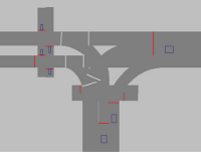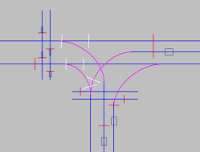Setting up a road network or PT link network
The basic element of a road network in Vissim is the link. Links can run in one direction over one or more lanes. You connect links via connectors; in this way, you construct the link network. The traffic can only flow via connectors from one link to another. It is not sufficient to model links without connectors attached or to have them overlap.
You can also use links and connectors to create a line network for public transportation (Modeling short-range public transportation).
In the road network or line network, you can add the required network objects exactly and define their attributes. Many network objects may lie on a link or connector, e.g. stop signs, routing decisions, PT lines or data collection points. Vehicle inputs may be positioned on links only. You can edit or delete network objects and attributes later on. For example, you may move a network object lying on a link or connector to a different position on the link or connector or copy it to a different link or connector.
Example for a simple network
The example shows a three-legged signalized intersection, with links, connectors, and other network objects:
| Icon | Network object |
|---|---|

|
Signal Heads |

|
Detectors |

|
Priority rules govern intersection control |
You can define the colors of network objects via the graphic parameters (Editing graphic parameters for network objects).
|
Wireframe display disable: Three-legged intersection with two pedestrian crossings |
Wireframe display enable: The network is represented via the middle lines of links (straight blue lines) and the middle lines of connectors (pink lines in the curves). |
Traffic network data
A Vissim traffic network is made up of the following data:
- Static data, which is not changed by the simulation.
- Dynamic data, which essentially includes all information that describes the simulated traffic.
Static data
Static data illustrates the applicable traffic infrastructure. This data is necessary for simulation and manual tests from traffic-dependent signal controls. Static data, for example, includes:
- Links with starting points and end points and perhaps intermediate points. Links are directional roadways on which traffic flows. For each link you specify a number of lanes.
- Connectors between links for the modeling of possible turns and from merging and broadening of lanes
- Position and length from public transport stop
- Position from signal head and stop line and references to the allocated signal groups
- Position and length of detectors used to record vehicles for vehicle-actuated signal control.
- Position of PT calling points that record PT vehicles sending PT telegrams
Dynamic data
For the simulation, you define dynamic data, for example:
- Vehicle inputs indicate congestion, including vehicle compositions, as relative shares, for example HGV shares for all links which lead into the network (Modeling vehicle inputs for private transportation).
- You define link sequences via routing decisions. You define routes via temporally variable traffic volumes that refer to vehicle classes (Modeling vehicle routing decision, vehicle routes and partial vehicle routes).
- The position and the values from Min. Clearances and Time Gaps from Priority Rules (Modeling priority rules). Priority Rules describe priority rules, for example, "right before left" or determines acceptable left turn.
- The curvature, departure times and boarding and alighting from public transport lines (Modeling PT lines)
Evaluating vehicular parameters from the network
You can determine and evaluate different network-based traffic-related parameters (Performing evaluations). Thereby, for example, you can apply the following network objects:
- Data collection points for user-defined local data collection measurements, for example, measurement of the number of vehicles of particular vehicle classes, their acceleration and average speed (Defining data collection points)
- Vehicle travel time measurements for the measurement of total travel times and delays when driving on the respective network segment (Defining vehicle travel time measurement)
- Queue counter for the measurement of average and maximum queue lengths (Modeling queue counters)
|
|
Note: The add-on module Viswalk allows for a comparison of pedestrian traffic evaluations. |
Superordinate topic:
Information on editing:




